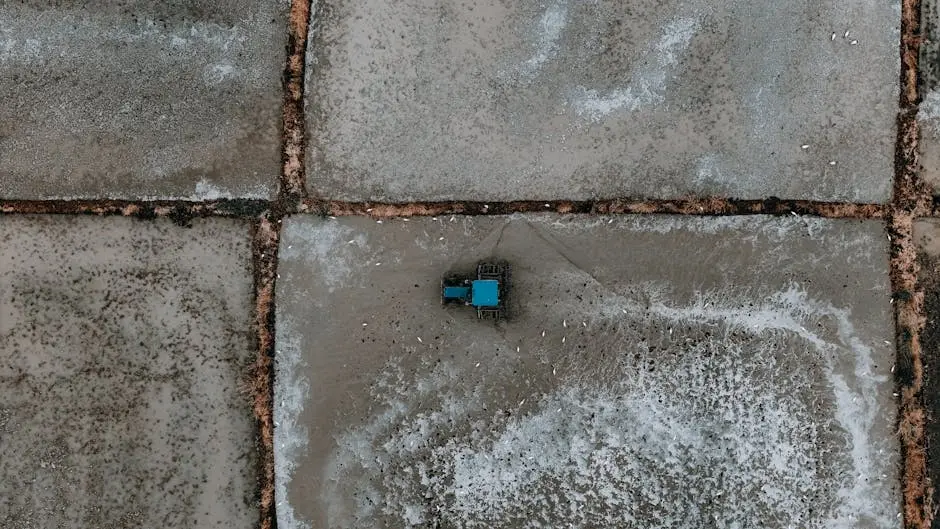
15 UAV Precision Agriculture Benefits You Can't Ignore
Share
Precision agriculture is transforming the way we approach farming. With the advent of UAV technology, the agricultural industry is seeing a wave of innovative techniques that promise to enhance productivity and sustainability. Let’s explore how UAVs are reshaping the landscape of modern farming.
1. Enhanced Crop Monitoring
UAVs offer a comprehensive view of crops, allowing farmers to monitor growth patterns and identify issues quickly. This detailed monitoring helps in making timely decisions to improve yield. By using high-resolution imagery, UAVs provide unparalleled insights into crop health, helping to identify problems such as pest infestations or nutrient deficiencies early. Early intervention minimizes damage and promotes healthier crops, ultimately leading to increased agricultural productivity.
Farmers are no longer tethered to traditional methods of scouting fields manually, which can be labor-intensive and time-consuming. With the capabilities of UAVs, farmers can easily perform frequent checks on their fields without setting foot on the soil. This means that crop management can be both proactive and reactive, adapting to the changing needs of the plants throughout their growth cycles.
2. Precision Spraying
With UAVs, farmers can achieve precise application of fertilizers and pesticides, ensuring that each plant receives exactly what it needs, reducing waste and chemical run-off. The ability of UAVs to hover and navigate exact paths over fields allows for targeted treatments. This targeted approach not only enhances plant care but also minimizes environmental impact, protecting both the crop and surrounding ecosystems.
Moreover, precision spraying reduces the amount of chemicals used, which is beneficial both economically and environmentally. Traditional methods often involve blanket spraying that doesn’t discern between healthy and ailing plants, leading to overuse of resources. UAV technology alleviates this issue by applying treatments only where necessary, helping to conserve inputs and reduce costs. This kind of precision also attracts consumers interested in sustainably-produced agricultural products.
3. Accurate Data Collection
UAVs collect high-quality data on soil health, moisture levels, and crop conditions, providing invaluable insights for optimizing agricultural practices. This data assists farmers in making evidence-based decisions to enhance crop production. Using advanced sensors, UAVs can gather data points that are impossible to capture with the naked eye, such as variations in leaf coloration that indicate nutrient uptake efficiency. These insights are crucial for tailored nutrient applications and irrigation scheduling.
The ability to analyze such comprehensive data sets allows farmers to adopt a more scientific approach in their farming practices. By harnessing the data collected by UAVs, agricultural professionals can develop future strategies that are both productive and sustainable, ensuring long-term viability of their lands. Through continuous monitoring and analysis, farmers can clearly track the progress of their interventions and adjust them as needed to optimize outcomes.
4. Improved Field Management
Drones help farmers plan and manage fields more effectively, identifying areas of concern and enabling targeted interventions. UAVs are equipped with advanced imaging capabilities that highlight variations in crop health and soil conditions across expansive fields. This level of detail makes it easier for farmers to pinpoint specific areas that require attention, whether it’s nutrient management, pest control, or irrigation adjustments. By knowing exactly where to focus their efforts, farmers can optimize their input and maximize their output.
5. Enhanced Crop Health Assessment
Using UAVs equipped with infrared sensors, farmers can detect plant health issues early, allowing for quick action to mitigate problems and improve plant vitality. Infrared technology enables detection of chlorophyll variation and leaf temperature changes, which are subtle indicators of plant health that are not visible to the naked eye. Identifying these signs promptly means that corrective measures can be implemented sooner, significantly reducing potential yield loss.
Not only does this early identification help in maintaining crop health, but it also offers an advantage in managing pest control measures. Pest outbreaks can be identified and controlled before they spread extensively, preventing significant damage. Farmers are thereby empowered to take immediate measures to protect and enhance crop growth, ensuring a healthier harvest season.
6. Efficient Resource Allocation
By using UAV-generated data, farmers can optimize the allocation of resources such as water, fertilizers, and labor, enhancing overall farm efficiency. With precise data highlighting the needs of crops in different field zones, farmers can tailor their resource usage accordingly. This ensures that no resources are wasted, leading to a more cost-effective and environmentally-friendly farming process. Additionally, UAVs enable more targeted deployment of workforce, reducing unnecessary labor costs and efforts.
7. Reduced Environmental Impact
Precision agriculture with UAVs leads to reduced chemical use and lower emissions, contributing to a more sustainable farming environment. By ensuring that inputs such as fertilizers and pesticides are applied precisely and only as needed, UAVs help minimize excess runoff into local water bodies. This targeted use not only conserves precious environmental resources but also supports biodiversity in agricultural regions.
Additionally, UAVs contribute to a smaller carbon footprint by enabling more efficient farming operations. Fuel and energy consumption are lowered because UAVs reduce the need for heavy machinery used in traditional survey methods, offering an eco-friendly alternative for modern agricultural practices. By embracing this technology, farmers can play a significant role in global efforts to combat climate change while improving their bottom line.
8. Cost-Effective Operations
Integrating UAVs into farm operations can lead to significant cost savings by optimizing inputs and reducing the need for manual labor. UAVs allow for automation of certain agricultural tasks that traditionally required substantial human labor, such as crop monitoring and field surveying. By automating these processes, farmers can reallocate human resources to more critical tasks or reduce labor costs entirely, achieving greater overall efficiency.
The efficiency gained from precise operations facilitated by UAVs translates into cost savings that are both immediate and long-term. The initial investment in UAV technology can often be recuperated through the savings derived from optimized input usage, reduced labor costs, and improved crop yields — a compelling incentive for farmers looking to improve their profitability. With UAVs, the agriculture sector can thrive economically while advancing technologically.
9. Real-Time Decision Making
UAVs provide farmers with real-time data, enabling fast and informed decision-making to address potential issues promptly. This immediacy is crucial in modern agriculture, where timely interventions can prevent costly problems. Equipped with real-time analytics, farmers are able to respond swiftly to changes in weather, pest activity, or crop conditions. Such agility ensures that potential threats to crop health are managed before significant damage occurs, securing better outcomes for the agricultural yield.
10. Improved Yield Prediction
Advanced analytics from UAV data improve the accuracy of yield predictions, assisting in planning and market strategies. The predictive power of this data helps farmers to anticipate market needs and adjust their production schedules accordingly. Understanding potential yields allows farmers to plan their marketing and sales strategies with greater precision, ensuring that they are well-prepared to meet consumer demand. This alignment between production capability and market demand ensures optimal profitability for farming enterprises.
Moreover, advanced yield predictions contribute to risk management strategies, offering farmers insights into likely scenarios and preparations they may need to put in place. These insights can be especially crucial in weather-dependent regions, helping farmers remain resilient in the face of unpredictable climate patterns. As predictive models grow more sophisticated through the use of UAV data, agricultural outputs will become increasingly reliable.
11. Increased Survey Efficiency
Conducting surveys using UAVs reduces the time and effort involved in traditional methods, providing faster and more comprehensive assessments. Time is a precious resource in agriculture, and being able to quickly gather and analyze data allows farmers to act faster and more effectively. With UAVs, large areas can be surveyed in a fraction of the time it takes with ground-based methods, offering substantial efficiency gains.
12. Enhanced Data Integration
UAVs enhance the integration of data from different sources, providing a more complete picture for precision farming strategies. By combining data sets from traditional sources with UAV data, farmers gain a holistic understanding of their agricultural environments. This comprehensive overview makes it easier to correlate various factors affecting crop health and soil conditions, leading to more effective and nuanced management strategies that cater to specific needs.
13. Detailed Topographic Mapping
Topographic maps created by UAVs aid in understanding field variations, thereby enhancing irrigation and drainage system designs. Detailed maps allow for precise adjustments to water management strategies, ensuring that fields receive adequate but not excessive water. This precision supports conservation efforts and enables sustainable water use. As farmers are able to develop irrigation plans that are responsive to real-time topographical nuances, they can ensure fields are healthier and more productive.
Such maps also play an essential role in the planning of new agricultural ventures. Whether establishing new fields or optimizing existing ones, topographic mapping informs essential decisions that maximize land productivity. By effectively planning the layout of fields and assessing potential areas of erosion or flooding risk, farmers can proactively manage challenges, maintaining productivity and reducing the chances of environmental degradation.
14. Streamlined Crop Insurance Assessments
UAVs provide objective and comprehensive data for insurance claims, simplifying the assessment process and ensuring accuracy. The reliability and accuracy of UAV-obtained data facilitate fair evaluations of insurance claims, improving trust between farmers and insurers. This results in faster processing times and fewer disputes. Incorporating UAV technology into insurance assessments enhances the overall transparency and efficiency of the claims process, benefiting all involved parties and building confidence in the agricultural insurance field.
15. Facilitated Research and Development
UAV technology supports ongoing agricultural research, allowing for the development and testing of new methods and practices that can be applied on a larger scale. By offering crucial data collection capabilities, UAVs are integral to experimental agricultural plots where researchers are exploring new crops, fertilizers, and farming techniques. The insights gained from UAV-backed research initiatives directly contribute to increased agricultural innovation and productivity.
Furthermore, UAV data accelerates the pace of agricultural advancements by enabling researchers to rapidly test hypotheses and gather results. The ability to conduct thorough analyses quickly allows new discoveries to transition from experimental stages to practical applications more efficiently. This industry-wide acceleration benefits farmers across the globe, empowering them to adapt swiftly to evolving agricultural challenges and opportunities.

